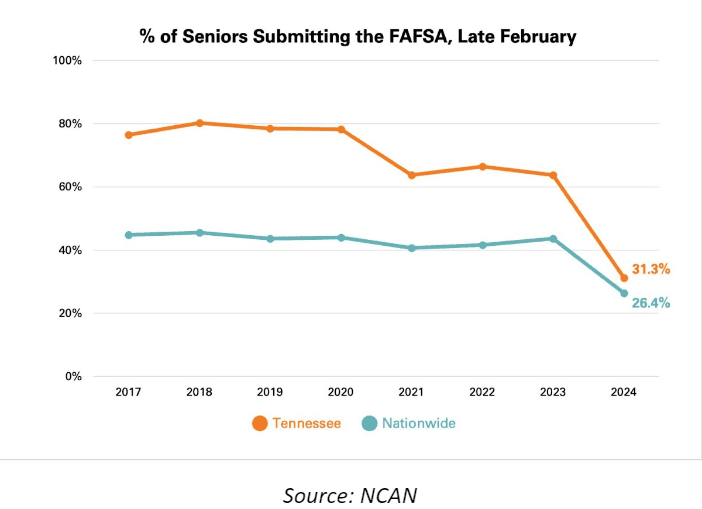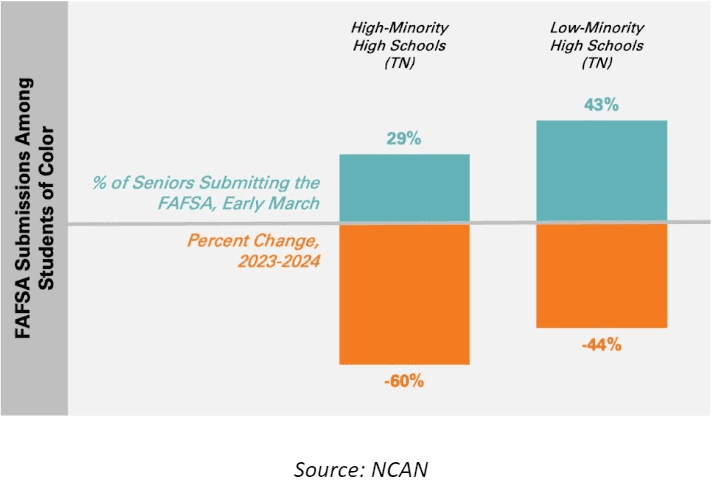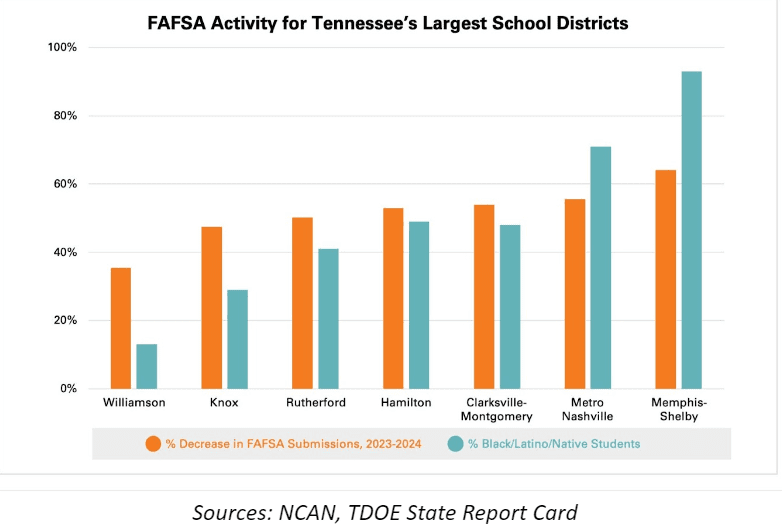
1. As of March 15, Tennessee’s FAFSA submission rate is 35 percentage points behind last year’s rate.
While the FAFSA is typically released to the public on October 1st, its 2023 deployment was delayed to December 30th to accommodate for the rollout of the Better FAFSA. This delay has significantly condensed the timeline for Tennessee’s students and families to complete their form. A student’s FAFSA is marked as “submitted” as soon as they deliver their form to the Office of Federal Student Aid (FSA). Only when FSA confirms that a student’s form contains all required elements is it marked “complete;” incomplete forms are returned to students for edits. College access advocates are monitoring FAFSA submission and completion rates to estimate the impact of this year’s FAFSA changes.
Nationwide data from the National College Attainment Network estimates that only 32.3% of high school seniors had submitted a FAFSA by March 15, 2024, down from 47.5% at the same time last year. Tennessee is 35 percentage points behind our submission rates in 2023, with only 39% submitting so far. As a longstanding leader in FAFSA submission, Tennessee’s 39% rate currently ranks seventh in the nation. Critically, though, delays and slowdowns have significantly reduced the variance in state-by-state FAFSA activity, reducing all states to devastatingly low numbers beneath Connecticut, which is highest at 44%.

2. Declines in FAFSA submissions are most acute in school districts with below-average college-going rates.
College-going rates estimate the portion of public high school graduates who immediately enroll in postsecondary education in the same year they graduate. Comparing county-level FAFSA submissions with county-level college-going rates reveals cause for concern. Johnson, Morgan, Fayette, Jackson, and Hardeman counties are experiencing the most severe declines in FAFSA activity, reporting submission rates more than 65% lower than last year’s. Each of these counties also reported college-going rates below 50% in 2022, trailing behind the statewide average of 54%. In rural and economically-disadvantaged communities, the financial aid options unlocked by the FAFSA are critical to students’ postsecondary enrollment decisions. FAFSA complications, particularly in these communities, could exacerbate already wide gaps in college-going.
3. FAFSA complications are having an outsized impact on students of color.
Historically, college-going in Tennessee has also been marked by racial equity gaps. For example, the college-going rate among Black high school graduates in 2022 was 46.9%, 7 percentage points below the statewide average of 54%. Latino students reported a 37.3% rate. Inequitable access to financial counseling and aid is one of the critical contributors to gaps in postsecondary enrollment.
NCAN’s FAFSA dashboard offers insight into FAFSA activity by race via its comparison of “high minority high schools” and “low minority high schools.” The dashboard defines “high minority high schools” as those with a student body composition of more than 40% Black and Latino students, and reports that only 29% of students at these high schools had submitted a FAFSA by the first week of March. In comparison, high schools with less diverse student bodies are performing above the state average, reporting a 43% FAFSA submission rate.

An analysis of Tennessee’s seven largest school districts provides a disaggregated look at the racial equity gaps presented by NCAN. Consider that Williamson and Knox counties – which enroll smaller proportions of students of color – are reporting milder impacts in FAFSA activity, while much more racially diverse districts like Metro Nashville and Memphis-Shelby County are witnessing severe effects. Because students of color are more likely to make college decisions based on financial cost, these disparities could have significant implications for Black and Latino college-going rates.

4. To accommodate for delays, scholarship deadlines in Tennessee have been extended.
In a normal application cycle, students receive financial aid packages alongside their offers of admission. This year, admissions and financial aid decisions are being decoupled due to delayed transfers of Institutional Student Information Records, i.e. ISIRs. The US Department of Education initially intended to initiate a delayed release of ISIRs in February, but quickly pushed its target back to mid-March. Today, the Department is experimenting with batched ISIR releases and facilitating an iterative improvement process. Early anecdotes suggest that “incomplete” FAFSAs will be flagged with higher frequency this year, meaning that even after ISIRs are transferred to institutions, many of them will be sent back to students for edits.
As scholarship application and enrollment deadlines rapidly approach, college access advocates are encouraging institutions to delay their timelines to give students more time to complete the FAFSA. In Tennessee, THEC announced a delayed timetable for state financial aid scholarship applications:
- April 15, 2024: Priority FAFSA Deadline for Tennessee Student Assistance Award (TSAA)
- May 15, 2024: FAFSA Deadline for Tennessee Promise Scholarship
- September 1, 2024: FAFSA Deadline for Tennessee HOPE Scholarship
Meanwhile, institutions are feeling pressure to extend their “reply by” dates. The National Association for College Admission Counseling is tracking deadline extensions across the country, and reports that the University of Memphis has pushed its “reply by” date to June 3. View NACAC’s latest directory updates here.
5. After months of glitches, mixed immigration status families can now complete the FAFSA without workarounds.
For more than two months after the initial release of the Better FAFSA, students who come from mixed-status families were running into multiple error messages within FSA’s electronic form, preventing them from completing the FAFSA. On March 12, the Department of Education announced that it had resolved these errors, with a few exceptions:
- Users without an Social Security Number are unable to directly transfer tax information into the FAFSA via the IRS, and will need to manually enter these financial inputs.
- “Personally Identifiable Information” for contributors without an Social Security Number is extremely sensitive to variation; the Department is continuing to explore solutions.
Prior to the March 12 update, families were instructed to use a workaround to ‘reserve’ their place in line for state and institution financial aid; those who used this temporary fix will need to return to the FAFSA to make final corrections. To assist students with parents without Social Security Numbers, the Department of Education has hired additional support staff at the FSA Information Center, including Spanish speakers.
Equity Considerations
- Financial aid is a critical tool for promoting postsecondary enrollment among students of color and students from low-income backgrounds. How are state agencies and college access organizations collaborating to ensure that information and support is reaching the students who need it most?
- The Department of Education has been unable to promptly field questions from students with parents without Social Security Numbers, due to the high volume of support requests. How are school counselors and college access professionals encouraging persistence among mixed-status families in the face of outsized obstacles?
Share This Story
